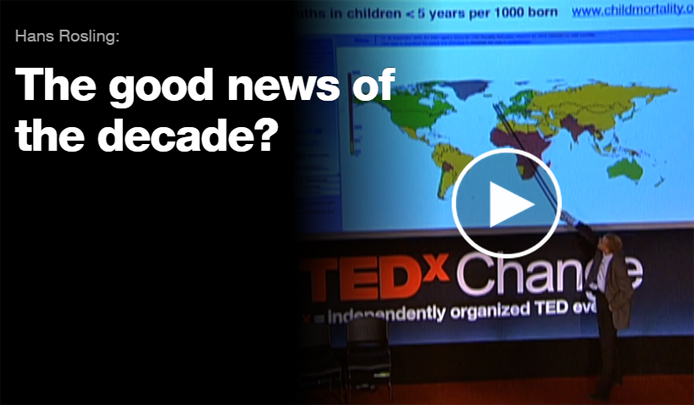Yes, there are pressing problems in the world this very day: A refugee crisis in Europe, a war-torn Syria, and grinding global poverty, to name a few. But according to Global Health expert and statistician, Hans Rosling, focusing on all the bad news in the media masks the real gains our world has achieved. I’m an advocate for taking every world problem we have seriously and focusing on finding real solutions. But let’s do so from a worldview with hope for the future and not one of gloom and doom. Here are 5 facts that many people don’t know:
(From BBC News Magazine, November 2013, Hans Rosling: How much do you know about the world?)
1 – Fast population growth is coming to an end – The world average fertility rate has dropped from 5.0 fifty years ago to 2.5 today and is still trending downwards. UN population experts predict that the number of children alive today, two billion, will stay level for the rest of the century. That means, although the population will continue to grow as these children grow old, in the second half of this century “the fast growth of world population will finally come to an end.”
2 – There is no longer a divided developing vs. developed world – Surely there are still developing countries with large numbers living in poverty, but progress has made the world into a continuum of stages of development, not rich nations compared to poor nations with few in the middle. Many formerly developing nations have caught up to the developed. Most of the world’s people live in the middle in countries like Brazil, Mexico, China, Turkey, and Thailand, and are more like the flourishing, rather than the deprived.
3 – People are much healthier – Today, the average life expectancy in the world is 70 years. Whereas fifty years ago it was 60 and there was a much lower average in developing countries, today’s average applies to most people on the planet. Many nations have caught up with the rest of the world in health quicker than in wealth. Child mortality has dropped from one in five children dying before age five to one in 20 children. Still tragic, but far, far less. Improved healthcare actually adds to population stability, not growth. Why? Because couples use family planning methods when child mortality goes down. They are more assured their children will live and want to stop having babies.
4 – Girls are getting better education – Today, in some poor countries like Bangladesh, girls attend school the same amount as boys. Girls are rapidly catching up to boys in education statistics–worldwide, boys have an average of eight years of school while girls have seven. Notwithstanding the needs in Pakistan where Malala Yousafzai has fought so herocially for the rights of girls to an education, the main reason for girls not being in school today is not cultural taboos but rather poverty.
5 – The end of extreme poverty is in sight – Not poverty overall, necessarily, but extreme poverty, meaning income less than $1.25 per day. The number of people in extreme poverty has fallen from two billion in 1980 to a little over one billion today. Evidence suggests the last billion people will pull themselves out of extreme poverty over the next few decades with the help of poverty-alleviating and government-enabling programs in micro-enterprise development, access to financial services and crop insurance for the poor, education, health improvements, and the surge of business solutions and strategies focused on the poorest.
Unlike the depressing reports we hear so often on the media, the world is at least headed in the right direction. Far from leading us to ignore the world’s problems, these facts should spur us to be hopeful that whatever global-improvement programs we support, they are contributing to these positive trends. Isn’t it about time the media give us more of the facts about these brighter developments?


